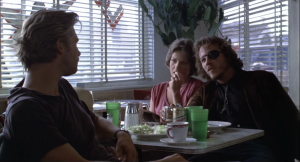Review by the Trylon’s grizzled war veteran Ben Schmidt
Over the course of the Trylon’s “Jeff Bridges Abides” series, the Bridges I’ve grown to know and love is not the Jeff Bridges that showed up for work on the set of Cutter’s Way. Here, playing low-rent playboy Richard Bone, Bridges displays little of the naive, charming troublemaker from The Last Picture Show. And there’s nary a wisp of the blissed out, impish drifter from Thunderbolt and Lightfoot. No. If Bridges to this point has been our lovable, shaggy, golden retriever, that which begins this film by easing itself from a married woman’s hotel bed to slink off into the night is nothing short of a mongrel.
What happened, Jeff Bridges? Acting? Perhaps. The need to sink into the dark script and sometimes bizarre world of Cutter’s Way could have posed quite a challenge for the young actor. And If it was a challenge he sought, Bridges rises admirably to it. His natural charisma completely inverted, Bone presents as a mottled former golden boy, worn hollow, or worse, at the core. It’s a performance that feels oddly similar to his Jack of The Fisher King, a character that charms you despite having fallen quite far from grace.
Here, as Cutter’s Way begins, Richard Bone may not yet have fallen, but he’s certainly on the way down. Leaving the aforementioned hotel, he edges his old car out into a dark, rain-soaked evening. Taking a shortcut through a back alley, his car stalls on him. Stepping out to assess the situation, he narrowly avoids being run over as another car races past, refusing to stop.
Alive but soaked, he curses his luck (and the Lord above for good measure) and runs off towards his destination. But in his rush and confusion, he fails to notice that tucked off nearby in the darkness the legs of a dead young woman hang plainly exposed over the edge of a garbage can.
Bone arrives at a (the) bar to find his friend Cutter, drunk and perhaps also insane (most certainly angry), doing his best to pick a fight with everyone around him. Cutter, we learn, is a Vietnam vet, who came back badly damaged from the war. Though they claim friendship, Cutter makes his old friend uneasy, and in a rage drives Bone away.
Bone returns home, to Cutter’s home actually, where he’s greeted by Cutter’s girl, Mo. There is some tension here. We gather, also, there’s some history here. And the fact that, despite the late hour, Mo sips directly from a (her second?) bottle of vodka suggests the history these three share is most likely complicated.
Around dawn, Cutter makes it home with the help of family friend Richard. But before he can pass out in the morning light, two detectives arrive at the door of this happy home. They’ve found the girl in the alley, along with Bone’s car. And Bone is hauled in to tell the cops what he knows.
Like the character it’s named for, Cutter’s Way seems obsessed with grit and a certain, oddly fierce cynical worldview. But this film does capture seemingly random moments of beauty.
One occurs here at the police station, where Bone stands in dismay as a police lieutenant, skeptical of both Bone’s story and alibi, sinks back into the chair behind his desk. The air hangs heavy. It’s silent for a moment as we lose sight of the policeman, obscured by the haze of smoke in the room and the sunlight glowing through the window blinds behind him. It’s a moment that wouldn’t be entirely out of place in the polished noir of Blade Runner.
Cinematic moments like this are rare in Cutter’s Way. Though it’s worth noting that this film and Blade Runner, released only a year apart, do coincidentally tie a white horse to the fates of their heroes.
In Ridley Scott’s film, the white horse is used symbolically, suggesting that a man may be realizing that he is, in fact, not one at all. This moment causes him to confront his path of violence. Has all this, we wonder alongside Deckard, been right?
However, in Cutter’s Way, a white horse delivers what’s left of a man violently and rather directly through a large mansion window. This moment causes Bone, our poor mongrel Bone, to confront his friend’s path of violence. Has all this, we wonder alongside Bone, been right?
Both films build to an ending where the viewer is left to wonder if one last life will be taken. And in what way (if any) that taking will matter.
Sure, between these two friends it may have always been Cutter’s way, fueled as much by injustice as alcohol. But in the end it’s our poor mongrel who is left with the final decision to make.
I wonder, could the younger, more optimistic Bridges have sold how this film resolves? — Ben Schmidt
CUTTER’S WAY screens Friday and Saturday, August 21 and 22 at 7:00 and 9:15, and Sunday, August 23 at 5:00 and 7:15. Advance tickets are $8.00, and you can purchase them here.

